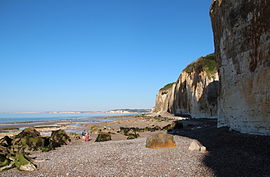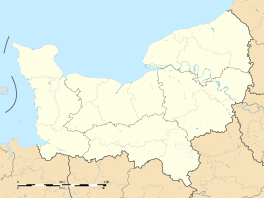Varengeville-sur-Mer
| Varengeville-sur-Mer | ||
|---|---|---|
 |
||
|
||
| Coordinates: 49°54′24″N 0°59′44″E / 49.9067°N 0.9956°ECoordinates: 49°54′24″N 0°59′44″E / 49.9067°N 0.9956°E | ||
| Country | France | |
| Region | Normandy | |
| Department | Seine-Maritime | |
| Arrondissement | Dieppe | |
| Canton | Dieppe-1 | |
| Intercommunality | Dieppe | |
| Government | ||
| • Mayor (2001–2008) | Christian Blanckaert | |
| Area1 | 10.75 km2 (4.15 sq mi) | |
| Population (2006)2 | 1,113 | |
| • Density | 100/km2 (270/sq mi) | |
| Time zone | CET (UTC+1) | |
| • Summer (DST) | CEST (UTC+2) | |
| INSEE/Postal code | 76720 /76119 | |
|
1 French Land Register data, which excludes lakes, ponds, glaciers > 1 km² (0.386 sq mi or 247 acres) and river estuaries. 2Population without double counting: residents of multiple communes (e.g., students and military personnel) only counted once. |
||
1 French Land Register data, which excludes lakes, ponds, glaciers > 1 km² (0.386 sq mi or 247 acres) and river estuaries.
Varengeville-sur-Mer is a commune in the Seine-Maritime department in the Normandy region in north-western France.
A forestry and farming commune situated by the coast of the English Channel and in the Pays de Caux, some 5 miles (8.0 km) west of Dieppe at the junction of the D27, D75 and the D123 roads. The commune has access to the pebble beach by means of a gap in the huge chalk cliffs.
The village is twinned with Herstmonceux in East Sussex, in the United Kingdom
Naomi Mitchison, in her autobiographic book "You may well ask", relates that in the 1920s and 1930 she and her family, along with other families of their social circle in London, used to have vacations in Varengeville: "At the small village of Varengeville, on top of the cliffs a few miles west of Dieppe, the families with children lived in fairly basic chalets which were fine for us. We ate at the hotel and went down a steep path to the sand and rather chilly swimming, and tremendously enjoyed each other's company".
...
Wikipedia



